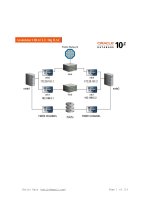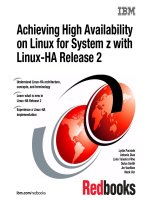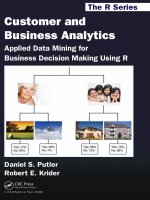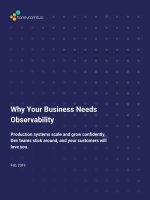IT training achieving real business outcomes AI ebook khotailieu
Bạn đang xem bản rút gọn của tài liệu. Xem và tải ngay bản đầy đủ của tài liệu tại đây (4.52 MB, 72 trang )
Co
m
pl
im
en
ts
Enterprise Considerations
for AI Initiatives
Atif Kureishy, Chad Meley
& Ben Mackenzie
of
Achieving Real
Business Outcomes
from Artificial Intelligence
DELIVERING
ANALYTICS
THAT MATTER
Most to Your Business,
Enabled by Artificial Intelligence.
AI offers timely answers and intelligent
automation to increase revenue,
improve operational efficiency, fight
fraud, and so much more. Teradata
brings you the industry-leading
products and expertise you need to
avoid complexity and accelerate your
digital transformation. It’s time you
started investing in answers.
Get the answer at teradata.com/AI.
Praise for Achieving Real Business Outcomes
from Artificial Intelligence
“A clear-eyed overview of the past, present, and future of AI in
commercial enterprises, with a particular focus on deep learning.
Teradata’s deep expertise in data and analytics comes to the fore here. A
great guide to getting started with AI.”
—Thomas H. Davenport, President’s Distinguished
Professor of IT and Management, Babson College; Fellow, MIT Initiative
on the Digital Economy; Senior Advisor to Deloitte’s Analytics and
Cognitive Practices
“Kureishy, Meley, and Mackenzie have provided concrete, real world
examples and case studies that show how AI and machine learning can
drive successful outcomes for organizations that are getting started with
artificial intelligence. The discussions on challenges and trade-offs will
be especially helpful to executives getting started in this exciting area.”
—Dave Schubmehl, Research Director,
Cognitive/AI Systems and Content Analytics, IDC
“If your company isn’t experimenting with AI—or already leveraging it
across some disciplines—you are behind your competitors. This book
provides a practical framework to understanding AI as a tool
positioned to disrupt our data-driven world. It provides great insights
on how companies who get AI right use it to predict and
meet customer needs.”
—Jim Lyski, Chief Marketing Officer at CarMax
“A fantastic list of use cases for prediction machines in practice.”
—Avi Goldfarb, Professor at University of Toronto
and author of Prediction Machines: The Simple
Economics of Artificial Intelligence
“An insightful discussion of AI for the executive, with real examples and
practical advice. This book helps you understand why AI is so critical
now and how to get started. A quick read you can’t afford to miss!”
—Richard Winter, CEO of WinterCorp
“This book cuts through the AI hype, clearly differentiates machine
learning and deep learning techniques, and focuses on practical, realworld use cases. It’s a must-read for anyone focused on getting to
better business outcomes.”
—Doug Henschen, Vice President and Principal
Analyst, Constellation Research
“In an industry where a significant understanding gap exists between
the technology and business, this book provides an easily accessible
overview for executive leadership seeking to understand how deep
learning can positively augment their enterprise.”
—BJ Yurkovich, Principle Investigator, Center for
Automotive Research, The Ohio State University
“A useful guide to help executives understand the promise of AI, with
concrete examples of how it is being applied now in business, that will
leave you with an urge to get started.”
—Mike Janes, Former GM of Worldwide Apple
Store and CMO at StubHub
“This book provides valuable insight for digital transformation leaders
on the impact that AI is having on an organization’s strategy,
technology, data, and talent.”
—Robertino Mera, Senior Director of Epidemiology,
Gilead Sciences
Achieving Real
Business Outcomes from
Artificial Intelligence
Enterprise Considerations
for AI Initiatives
Atif Kureishy, Chad Meley,
and Ben Mackenzie
Beijing
Boston Farnham Sebastopol
Tokyo
Achieving Real Business Outcomes from Artificial Intelligence
by Atif Kureishy, Chad Meley, and Ben Mackenzie
Copyright © 2019 O’Reilly Media. All rights reserved.
Printed in the United States of America.
Published by O’Reilly Media, Inc., 1005 Gravenstein Highway North, Sebastopol, CA
95472.
O’Reilly books may be purchased for educational, business, or sales promotional use.
Online editions are also available for most titles ( For more
information, contact our corporate/institutional sales department: 800-998-9938
or
Acquisitions Editor: Rachel Roumeliotis
Development Editor: Jeff Bleiel
Production Editor: Justin Billing
Copyeditor: Octal Publishing, Inc.
Proofreader: Sharon Wilkey
Interior Designer: David Futato
Cover Designer: Karen Montgomery
Illustrator: Court Patton
First Edition
October 2018:
Revision History for the First Edition
2018-10-02:
First Release
The O’Reilly logo is a registered trademark of O’Reilly Media, Inc. Achieving Real
Business Outcomes from Artificial Intelligence, the cover image, and related trade
dress are trademarks of O’Reilly Media, Inc.
The views expressed in this work are those of the authors, and do not represent the
publisher’s views. While the publisher and the authors have used good faith efforts
to ensure that the information and instructions contained in this work are accurate,
the publisher and the authors disclaim all responsibility for errors or omissions,
including without limitation responsibility for damages resulting from the use of or
reliance on this work. Use of the information and instructions contained in this
work is at your own risk. If any code samples or other technology this work contains
or describes is subject to open source licenses or the intellectual property rights of
others, it is your responsibility to ensure that your use thereof complies with such
licenses and/or rights.
This work is part of a collaboration between O’Reilly and Teradata. See our statement
of editorial independence.
978-1-492-03818-4
[LSI]
Table of Contents
Foreword. . . . . . . . . . . . . . . . . . . . . . . . . . . . . . . . . . . . . . . . . . . . . . . . . . . . . vii
Acknowledgments. . . . . . . . . . . . . . . . . . . . . . . . . . . . . . . . . . . . . . . . . . . . . xi
1. Artificial Intelligence and Our World. . . . . . . . . . . . . . . . . . . . . . . . . . . . 1
A New Age of Computation
The AI Trinity: Data, Hardware, and Algorithms
What Is AI: Deep Versus Machine Learning
What Is Deep Learning?
Why It Matters
2
2
4
5
7
2. More Than Games and Moonshots. . . . . . . . . . . . . . . . . . . . . . . . . . . . . 9
AI-First Strategy
Where Deep Learning Excels
Financial Crimes
Manufacturing Performance Optimization
Recommendation Engines
Yield Optimization
Predictive Maintenance
9
10
11
11
12
13
13
3. Options and Trade-Offs for Enterprises to Consume Artificial
Intelligence. . . . . . . . . . . . . . . . . . . . . . . . . . . . . . . . . . . . . . . . . . . . . . . 17
SaaS Solutions: Quick but Limited
Cloud AI APIs
Building Custom AI Algorithms
17
18
19
v
4. Challenges to Delivering Value from Custom AI Development and
Engineering Countermeasures. . . . . . . . . . . . . . . . . . . . . . . . . . . . . . . 21
Strategy
Technology
Operations
Data
Talent
Conclusion
22
23
24
28
29
30
5. Artificial Intelligence Case Studies. . . . . . . . . . . . . . . . . . . . . . . . . . . . 31
Fighting Fraud by Using Deep Learning
Mining Image Data to Increase Productivity
Deep Learning for Image Recognition
Natural-Language Processing for Customer Service
Deep Learning for Document Automation
Conclusion
31
33
34
34
35
36
6. Danske Bank Case Study Details. . . . . . . . . . . . . . . . . . . . . . . . . . . . . . 37
The Project, the Tools, and the Team
Getting the Right Data in Place
Ensemble Modeling and Champion/Challenger
Working with the Past, Building the Future
Moving the ML Models into Live Production
From Machine Learning to Deep Learning
Visualizing Fraud
Visualizing and Interpreting Deep Learning Models
A Platform for the Future
38
39
40
40
41
41
42
44
45
7. Predictions Through 2020. . . . . . . . . . . . . . . . . . . . . . . . . . . . . . . . . . . 47
Strategy
Technology
Operations
Data
Talent
What’s Next
48
49
50
52
53
53
8. Conclusion. . . . . . . . . . . . . . . . . . . . . . . . . . . . . . . . . . . . . . . . . . . . . . . . 55
Identify High-Impact Business Outcomes
Assess Current Capabilities
Build Out Capabilities
vi
|
Table of Contents
55
56
56
Foreword
Enterprises are under the impression that they’re on their way to
using artificial intelligence. They’ve set up a few machine learning
models and have had new algorithms work their way into previously
deployed Software as a Service applications. Inside the organization,
it feels like they’re checking all the right artificial intelligence (AI)
boxes.
But the true end goal of AI in the enterprise is something much
more sophisticated. Oliver Ratzesberger and Mohanbir Sawhney
expressed it succinctly in their book, The Sentient Enterprise, noting,
“Our objective is to position the enterprise in such a way that ana‐
lytic algorithms are navigating circumstances and making the bulk
of operational decisions without human help.”
With the exception of a few Bay Area tech giants, the industry hasn’t
experienced highly proficient natural-language processing, imagebased detection, or other skills that would enable this next genera‐
tion of AI to drive significant business outcomes instead of just
performing basic business tasks.
Imagine if AI platforms could identify and bring together data sour‐
ces and then explain to their human counterparts the “why” behind
the recommendations—something like AI for data engineering and
data science. Or, imagine if chatbots could interpret problems and
provide solutions using natural language that satisfy buyers more
quickly and more effectively than current call centers. Imagine if key
business functions were being driven by algorithms with the neces‐
sary autonomy to self-learn and change tactics at a level of speed
and accuracy that far surpasses any human or team of humans.
vii
These scenarios will one day be mainstream, but how are companies
going to get there?
One of the biggest challenges for AI in the enterprise is that each
company—even within the same industry—has unique problems.
So, for the most part, businesses today need custom AI solutions to
drive specific value.
However, the reality for most companies is that homegrown, custom
AI solutions aren’t feasible for a number of reasons. Not only is it an
expensive initiative to take on, but AI development also has a very
small talent pool, and it would be difficult to get that kind of brain
trust in one organization at an affordable, sustainable rate. The
information and opportunity for AI development, however, is out
there. To truly accelerate AI, companies should work with partners
that have created custom AI solutions before, enabling them to
share a vision for how AI will drive business outcomes.
AI is not going to be easy. There is no out-of-the-box AI solution
that will transform a company overnight. Instead, building a custom
AI solution will take persistent, coordinated effort and deep organi‐
zational change. These investments will be necessary not only to
develop AI capabilities; they will be necessary for companies to sur‐
vive.
This book is a thoughtful primer for digital transformation leaders
in large enterprises seeking to outpace their competition by embrac‐
ing the technological and organizational change that comes with AI.
In it, the authors review potential enterprise AI use cases and dis‐
cuss authentic case studies in which companies have realized value
from custom AI solutions. For those readers looking for a higher
level of engineering detail, the authors include a technical dive into a
deep learning solution implemented at Danske Bank.
You will gain insight into the very real challenges that organizations
will face as they make this difficult but necessary transition, and var‐
ious measures that you can implement to approach those challenges.
Finally, the book includes a look toward the next several years of AI
innovation to give a preview of what organizations can expect to see.
Ultimately, this book provides a practical roadmap for understand‐
ing how an enterprise can begin to approach using artificial intelli‐
gence to harness its most powerful asset: data.
viii
|
Foreword
— Diego Klabjan
Professor, Director of Master of
Science in Analytics
Northwestern University
Professor Klabjan’s research focuses on developing models and
algorithms for machine learning, in particular deep learning, prob‐
lems with emphasis on the industries of healthcare, marketing,
sports, and finance. He has led data science projects with large
companies such as Intel, Allstate, HSBC, The Chicago Mercantile
Exchange, FedEx, General Motors, and many others.
Foreword
|
ix
Acknowledgments
This book incorporates perspectives from a diverse group of people
to whom we would like to express our deep gratitude.
Our Customers
We have had the privilege to collaborate with some of the leading
data-driven companies across various industries as they take the
next step in their analytic evolution, and many have allowed us to
share their stories here by name or anonymously. As this is a new
field, we have all learned together, and we are grateful for that
opportunity.
Our Talented Data Scientists
Data scientists with enterprise-tested deep learning credentials are
scarce indeed, and we have been fortunate to call a number of them
our colleagues. Their contributions to this book were invaluable in
properly documenting the challenges and countermeasures enter‐
prises face when taking on an artificial intelligence (AI) initiative. In
particular, we’d like to offer a special thanks to Eliano Marques, Sune
Askjaer, Chanchal Chatterjee, Peter Mackenzie, David Mueller,
Frank Saeuberlich, and Yasmeen Ahmad.
Industry Analysts
We are voracious consumers of the insights provided by analysts
covering the intersection of AI and Enterprise Digital Transforma‐
tion—notably, those of IDC, Gartner, and Forrester. Their research,
responses to our inquiries, and participation at our events has hel‐
xi
ped shape our point of view on AI market trends. Thank you for
sharing your insights with us.
Our Community
Much inspiration has been drawn from associating with NVIDIA
and our other industry partners as well as organizations that share
our passion for moving the AI industry forward, including Neural
Information Processing Systems (NIPS), Stanford DAWN, O’Reilly
AI Conference attendees, and various professional meetups and
hackathons in North America, Europe, and Asia. Thank you for
your enthusiasm, passion, and dedication to the AI industry.
xii
| Acknowledgments
CHAPTER 1
Artificial Intelligence and Our
World
Recent advances in artificial intelligence (AI) have sparked increased
interest in what the technology can accomplish. It’s true that there’s
hype—as there often is with any breakthrough technology—but AI
is not just another fad. Computers have been evolving steadily from
machines that follow instructions to ones that can learn from expe‐
rience in the form of data. Lots and lots of it.
The accomplishments are already impressive and span a variety of
fields. Google DeepMind has been used to master the game of Go;
autonomous vehicles are detecting and reacting to pedestrians, road
signs, and lanes; and computer scientists at Stanford have created an
artificially intelligent diagnosis algorithm that is just as accurate as
dermatologists in identifying skin cancer. AI has even become com‐
monplace in consumer products and can be easily recognized in our
virtual assistants (e.g., Siri and Alexa) that understand and respond
to human language in real time.
These are just a few examples of how AI is affecting our world right
now. Many effects of AI are unknown, but one thing is becoming
clearer: the adoption of AI technology—or lack of it—is going to
define the future of the enterprise.
1
A New Age of Computation
AI is transforming the analytical landscape, yet it has also been
around for decades in varying degrees of maturity. Modern AI, how‐
ever, refers to systems that behave with intelligence without being
explicitly programmed. These systems learn to identify and classify
input patterns, make and act on probabilistic predictions, and oper‐
ate without explicit rules or supervision. For example, online retail‐
ers are generating increasingly relevant product recommendations
by taking note of previous selections to determine similarities and
interests. The more users engage, the smarter the algorithm grows,
and the more targeted its recommendations become.
In most current implementations, AI relies on deep neural networks
(DNNs) as a critical part of the solution. These algorithms are at the
heart of today’s AI resurgence. DNNs allow more complex problems
to be tackled, and others to be solved with higher accuracy and less
cumbersome, manual fine tuning.
The AI Trinity: Data, Hardware, and
Algorithms
The story of AI can be told in three parts: the data deluge, improve‐
ments in hardware, and algorithmic breakthroughs (Figure 1-1).
Figure 1-1. Drivers of the AI Renaissance
2
| Chapter 1: Artificial Intelligence and Our World
Exponential Growth of Data
There is no need to recite the statistics of the data explosion of the
past 10 years; that has been mainstream knowledge for some time.
Suffice it to say that the age of “big data” is one of the most well
understood and well documented drivers of the AI renaissance.
Before the current decade, algorithms had access to a limited
amount and restricted types of data, but this has changed. Now,
machine intelligence can learn from a growing number of informa‐
tion sources, accessing the essential data it needs to fuel and
improve its algorithms.
Computational Advances to Handle Big Data
Advanced system architectures, in-memory storage, and new AIspecific chipsets in the form of graphics processing units (GPUs) are
now available, advances that overcome previous computational con‐
straints to advancing AI.
GPUs have been around in the gaming and computer-aided design
(CAD) world since 1999, when they were originally developed to
manipulate computer graphics and process images. They have
recently been applied to the field of AI when it was found that they
were a perfect fit for the large-scale matrix operations and linear
algebra that form the basis of deep learning. Although parallel com‐
puting has been around for decades, GPUs excel at parallelizing the
same instructions when applied to multiple data points.
NVIDIA has cemented itself as the leader in AI accelerated plat‐
forms, with a steady release of ever powerful GPUs, along with a
well executed vision for CUDA, an application programming inter‐
face (API) that makes it easier to program GPUs without the need
for advanced graphic programming skills. Leading cloud vendors
like Google, Amazon, and Microsoft have all introduced GPU hard‐
ware into their cloud offerings, making the hardware more accessi‐
ble.
Accessing and Developing Algorithms
Whereas AI software development tools once required large capital
investments, they are now relatively inexpensive or even free. The
most popular AI framework is TensorFlow, a software library for
machine learning originally developed by Google that has since been
The AI Trinity: Data, Hardware, and Algorithms
|
3
open sourced. As such, this world-class research is completely free
for anyone to download and use. Other popular open source frame‐
works include MXNET, PyTorch, Caffe, and CNTK.
Leading cloud vendors have packaged AI solutions that are deliv‐
ered through APIs, further increasing AI’s availability. For instance,
AWS has a service for image recognition and text-to-speech, and
Google has prediction APIs for services such as spam detection and
sentiment analysis.
Now that the technology is increasingly available with hardware to
support it and a growing body of practice, AI is spreading beyond
the world of academia and the digital giants. It is now on the cusp of
going mainstream in the enterprise.
What Is AI: Deep Versus Machine Learning
Before venturing further into talking about AI, it will be helpful to
discuss what is meant by the terms in this book.
The term artificial intelligence has many definitions. Of these, many
revolve around the concept of an algorithm that can improve itself,
or learn, based on data. This is, in fact, the biggest difference
between AI and other forms of software. AI technologies are ever
moving toward implicit programming, where computers learn on
their own, as opposed to explicit programming, where humans tell
computers what to do.
Several technologies have—at various points—been classified under
the AI umbrella, including statistics, machine learning, and deep
learning. Statistics and data mining have been present in the enter‐
prise for decades and need little introduction. They are helpful for
making simple business calculations (e.g., average revenue per user).
More advanced algorithms are also available, drawing on calculus
and probability theory to make predictions (e.g., sales forecasting or
detecting fraudulent transactions).
Machine learning makes predictions by using software to learn from
past experiences instead of following explicitly programmed
instructions. Machine learning is closely related to (and often over‐
laps with) statistics, given that both focus on prediction making and
use many of the same algorithms, such as logistic regression and
decision trees. The key difference is the ability of machine learning
models to learn, which means that more data equals better models.
4
|
Chapter 1: Artificial Intelligence and Our World
This book, however, focuses on deep learning, which is at the heart
of today’s AI resurgence as recent breakthroughs in the field have
fueled renewed interest in what AI can help enterprises achieve. In
fact, the terms AI and deep learning are used synonymously (for rea‐
sons we discuss in a moment). Let’s delve into that architecture.
What Is Deep Learning?
Building on the advances of machine learning, deep learning detects
patterns by using artificial neural networks that contain multiple
layers. The middle layers are known as hidden layers, and they
enable automatic feature extraction from the data—something that
was impossible with machine learning—with each successive layer
using the output from the previous layer as input. Figure 1-2 briefly
summarizes these advancesments over time.
The biggest advances in deep learning have been in the number of
layers and the complexity of the calculations a network can process.
Although early commercially available neural networks had only
between 5 and 10 layers, a state-of-the-art deep neural network can
handle significantly more, allowing the network to solve more com‐
plex problems and increase predictive accuracy. For example, Goo‐
gle’s speech recognition software improved from a 23% error rate in
2013 to a 4.9% error rate in 2017, largely by processing more hidden
layers.
What Is Deep Learning?
|
5
Figure 1-2. Evolution of AI
6
| Chapter 1: Artificial Intelligence and Our World
Why It Matters
Because of its architecture, deep learning excels at dealing with high
degrees of complexity, forms, and volumes of data. It can under‐
stand, learn, predict, and adapt, autonomously improving itself over
time. It is so good at this that in some contexts, deep learning has
become synonymous with AI itself. This is how we will be using the
term here.
Here are some differentiators of deep learning:
• Deep learning models allow relationships between raw features
to be determined automatically, reducing the need for feature
engineering and data preprocessing. This is particularly true in
computer vision and natural language–related domains.
• Deep learning models tend to generalize more readily and are
more robust in the presence of noise. Put another way, deep
learning models can adapt to unique problems and are less
affected by messy or extraneous data.
• In many cases, deep learning delivers higher accuracy than
other techniques for problems, particularly those that involve
complex data fusion, when data from a variety of sources must
be used to address a problem from multiple angles.
In Chapter 2, we will examine how this technology is changing the
enterprise.
Why It Matters
|
7
CHAPTER 2
More Than Games and Moonshots
Although it might be easy to dismiss artificial intelligence (AI) use
cases highlighted by the media as “moonshots” (e.g., curing cancer),
publicity stunts (e.g., beating the best human players at Go and
Jeopardy), too industry-specific (e.g., autonomous driving), or edge
use cases and point solutions (e.g., spam filtering), we can apply
deep learning to core strategic initiatives across many verticals. In
fact, AI has already begun to demonstrate its value in large enterpri‐
ses, even outside Silicon Valley and West Coast digital giants. For‐
tune 500 companies in industries like banking, transportation,
manufacturing, retail, and telecommunications have also begun to
take advantage of its power.
AI-First Strategy
In an AI-first strategy, AI operates at the core of a company, driving
its product and decision-making. In several industries, new chal‐
lengers are using this kind of strategy to successfully compete
against incumbents. One example is in the financial industry, with
companies like Citadel, Two Sigma, and Personal Capital maximiz‐
ing return and reducing risk by creating the best machine intelli‐
gence. And in the automotive industry, it’s now easy to envision a
day when people will decide to buy a new car based on its driving
software and not on its engine, body design, or other buying criteria.
Across all industries, the use of deep learning has the potential to
increase production, drive down cost, reduce waste, and improve
efficiency, as well as push innovation. And, as can be seen in indus‐
9
try leaders like Google, Apple, and Amazon, machine intelligence
changes everything and becomes pervasive when an organization
pieces together how to use it.
Though we cannot predict its full impact, it’s clear that AI represents
profound change both in the short and long term, and it is a tech‐
nology that demands strategic focus and action.
Where Deep Learning Excels
Deep learning is not the best approach for every problem, and more
basic tools such as stats and machine learning aren’t going away any‐
time soon. But deep learning is extremely powerful when we have
access to plenty of training data, we have many dimensions or fea‐
tures of the data (which would require time-consuming feature
extraction in order to conduct machine learning), or we need to
process rich media such as images, video, and audio.
In the short term, the techology holds significant promise for deal‐
ing with problems like fraud detection, predictive maintenance, rec‐
ommendation engines, yield optimization, and churn reduction. In
these areas, it could produce order-of-magnitude improvements in
two ways:
In some cases, deep neural networks will yield better predictability over
current models even when using the same dataset
Later in the book, we discuss how deep learning models were
able to detect fraud much more predictably than machine learn‐
ing ones at Danske Bank, even using the same data as priorgeneration models.
Deep learning can allow the enterprise to analyze previously intracta‐
ble datasets
For example, companies could use images and audio files for
predictive maintenance, as in mining photos of a piston in an
engine to spot cracks and other imperfections before they
become more serious or using audio from wheel bearings in a
train to listen for anomalies that signal a potential derailment.
Let’s take a look at some use cases for which deep learning could
provide a significant advantage over current prediction methods.
10
|
Chapter 2: More Than Games and Moonshots
Financial Crimes
Financial crimes cost institutions, consumers, and merchants bil‐
lions of dollars every year. In the past, fraud was more difficult to
perpetrate because banking was personal and channels for crime
were more constrained. The internet has changed that. Modern
banking is almost completely anonymous and occurs through many
avenues. This has enabled a new ecosystem of many kinds of fraud,
which are growing increasingly sophisticated and aggressive. Both
industries and governments face unprecedented threats from a vari‐
ety of actors, risking physical loss of money, intellectual property
theft, and damage to their reputations.
Financial institutions have long been using machine learning, data
mining, and statistics to mitigate risk, and these have certainly pro‐
vided value. Today’s risk landscape, however, demands new tools.
Though deep learning didn’t initiate real-time or cross-channel data
analysis, it is better at detecting more accurate patterns across all
data streams, in addition to its ability to analyze new types of data.
Because of this, AI can empower banks and other institutions with
insight that keeps up with the pace of modern fraud.
Manufacturing Performance Optimization
Currently, the manufacturing industry suffers from inefficiencies
due to “siloed” data and delayed communication of insights across
the supply chain, from the acquisition of raw goods through pro‐
duction and sales. Improving this efficiency represents a huge
opportunity for manufacturers.
Iterating on manufacturing processes is nothing new—it’s some‐
thing that has been done for decades. However, AI can permit itera‐
tions and adjustments to systems in minutes instead of months.
The increased predictive power of AI enables companies to proac‐
tively understand their needs and intelligently communicate them
across their different branches. This can have a huge impact on
every part of the business. According to data from General Electric,
smart manufacturing systems using AI can increase production
capacity up to 20% while lowering material consumption by 4%.
AI provides data to the business in real time, which can help opti‐
mize the supply chain, provide greater economies of scale, and bet‐
Financial Crimes
|
11









